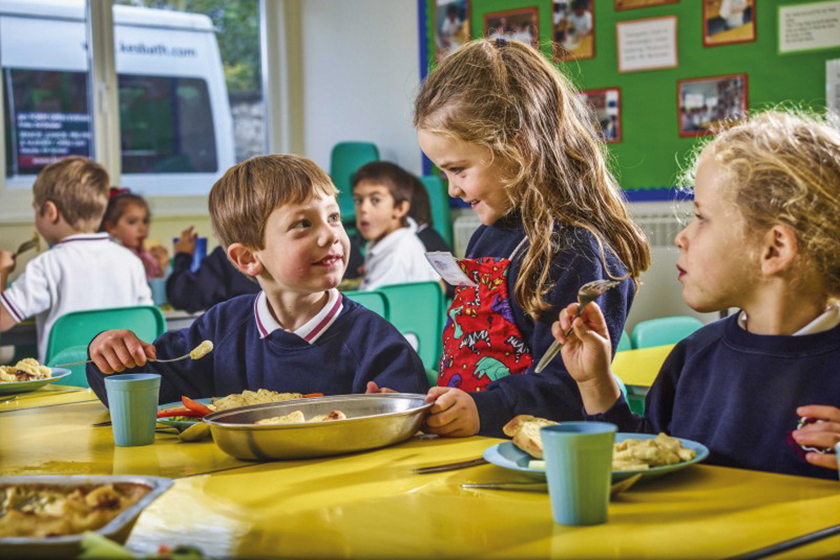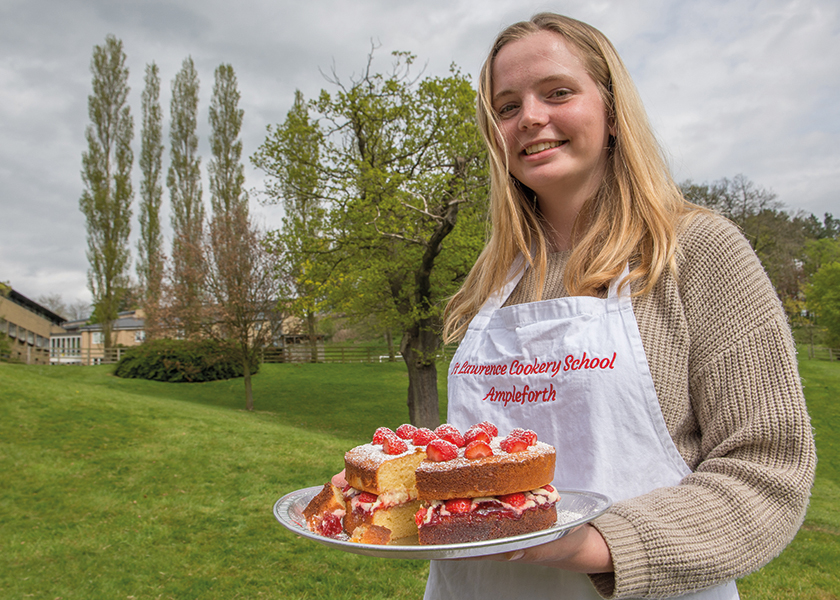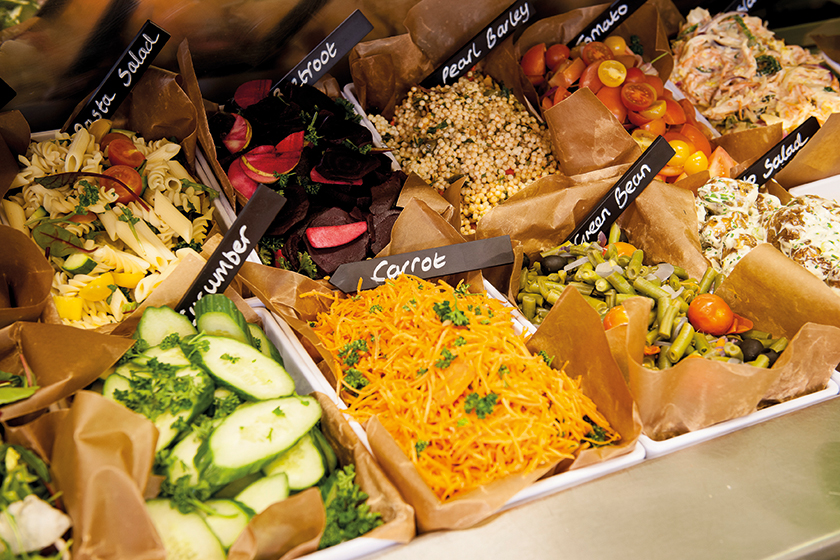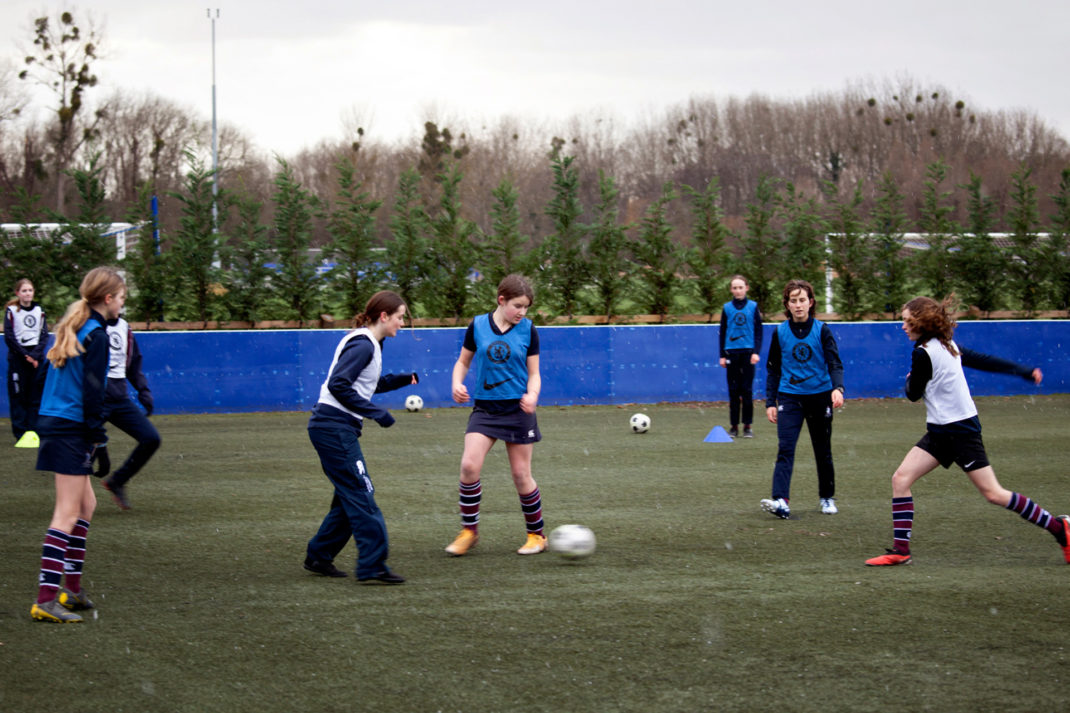Why School Dinners are Better Than Ever
By
7 years ago
Move over turkey twizzlers, healthy eating is back on the menu

School dinners ain’t what they used to be finds Matthew Fort.

There’s a stirring in the corridor of the dining room at Wellington School, Taunton. A face peers through a glass panel of the door. It’s 11.57. Precisely on the dot of 12 noon, the school’s catering manager, Jane Cull, unlocks the door and a burst of pupils, who’ve been waiting outside with undisguised restlessness, stream through in a determined but orderly fashion, collect trays and plates and make their way to the counter. They hold out their plates to be piled with slices of roast pork or chicken thighs. Further along the counter, a chef is serving up tacos stuffed with pulled pork or the vegetarian Quorn equivalent, they help themselves to one of five vegetables or salads from the salad bar, and settle down to eat. This is a scene that is being replicated in independent schools all over the country.
When my mother became headmistress of Roedean in 1961, almost the first thing she had to do was raise money for new school kitchens and dining rooms. This emphasis on a school having the resources to produce decent, wholesome food and serve it in reasonably pleasing surroundings was not so much novel as revolutionary at the time. Many parents who cast their minds back to the food of their own school days may well shudder at the memory. My own is haunted by grainy liver with sludge-like gravy, pilchards resting in rust-coloured tomato sauce shiny with oil and stringy ham with ‘parsley sauce’ – the texture and taste of wallpaper paste. Little attention was given to notions of nutritional quality, health or the connection between eating properly and the ability to learn.
Cooking in schools
Recently, Ampleforth in Yorkshire announced that it had invested £56,000 in the new St Lawrence Cookery School while LVS Ascot boasts that one of its pupils, Jamie Edwards, has just been named as the youngest ever winner of the Rotary Young Chef competition.

King Edward’s School, Bath, has an in-house setup overseen by head chef, Marcus Miller. The school employs its own cooking staff and the head chefs at each of the pre-prep, junior and senior schools have the freedom to devise their own menus and source their own ingredients.
‘It gives us much greater control over quality and price,’ says bursar Jonathan Webster. ‘We are proud of the school dinners we serve our pupils, and when we show parents around, we make sure they see the kitchens and talk to our chefs.’ At KES, food is on the curriculum up to GCSE and each school also has its own gardening and cooking club.
Henry Price, the headmaster of Wellington School cooks himself, but notes, ‘I’m not as good as my wife’. He’s adamant about the need ‘to develop good eating and exercise habits and a sense of wellbeing’ at school. He goes on, ‘Education shouldn’t be all about exams, vitally important as those are. We want to instil good mental and physical practices that they’ll take through the rest of their lives.’
School cantering contracts
Wellington School contracts its school dinners to a small catering company, Palmer & Howells, but Jane Cull, the catering manager, who is employed directly by Palmer & Howells, enjoys complete freedom when it comes to planning menus and buying ingredients. ‘Ninety-five per cent of the food we serve is freshly prepared from scratch here in the school kitchens. The quality and healthy balance of the dishes are incredibly important for the pupils.’ She sources as much of the produce as she can locally, using both a local fishmonger and butcher.
Mark Newman has been responsible for the food at the five Thomas’s Schools in London since they sacked their contract caterers in 2003. Like many schools, he plans his menus with the help of a nutritionist on a three-week rolling basis, changing them completely every six weeks. Like all the people responsible for school dinners, chefs and catering managers, he’s acutely aware of allergies and the need for special diets, whether for health or cultural reasons. Nuts are universally banned. Every school offers gluten-free options and are sensitive to other intolerances that have gained light in recent years, such as lactose intolerances, even though schools prefer to meet these needs on the main school menu.
‘We don’t really like singling out individual children for special treatment unless it’s strictly justified. It can be counter-productive,’ says Mark Newman.
School dinners: what’s on the menu?
Whether the children are aware of the careful planning that goes into their daily diet may be open to question. Most children tend to treat lunch as if it were a Formula 1 pit stop on their way to other activities. ‘Fifteen minutes at most,’ reckons Jim Gavin, ‘that’s what they spend over lunch.’
That’s not to say they gulp down food without any critical attention to its quality. In all four schools, the pupils were appreciative of the efforts to give them healthy, tasty food, whether it be carrot soup with quinoa and feta (Wellington); Thai prawns with stir fried vegetables (Thomas’s); beetroot and goat’s cheese flatbreads (LVS); faggots with onion gravy (KES); butter bean, tomato and grill gratin (Wellington); roasted red peppers filled with spicy puy lentils, topped with organic cheese (Thomas’s) or pot-roasted chicken thighs, bacon and bean cassoulet with bubble and squeak, green beans and sautéed courgettes (LVS).

The range of the dishes on offer is, in itself, evidence of how children’s gastronomic sophistication has changed.
‘Children are much more savvy about food these days,’ says Jim Gavin. ‘There’s such broad coverage in the media and they travel so much.’
Best school canteens
Even the conditions in which pupils eat their school dinners can affect the way they relate to food. Two years ago, KES opened a remarkable new building, with a library on the ground floor and a lecture theatre on top with a kitchen and dining hall sandwiched between them. Dining is in the bright, light Willett Dining Hall with spectacular views out over the city and space to eat outside, all designed specifically with the children in mind.
‘We’ve noticed that the pupils tend to spend longer at the tables over lunch than they used to,’ says the head chef.
When any parent chooses a school for their child, food is unlikely to come at the top of the list of criteria. Teaching facilities will be examined with care, sports facilities assessed, exam results chewed over and yet, a child is unlikely to succeed in any of these areas unless properly fed. Any eating habits they pick up at school are likely to remain with them throughout their lives.
So a visit to the dining room, a tour of the kitchen to see how up-to-date the equipment is, a chat to the chef and catering manager, a look at the menu of the day or even time spent watching a lunch, and an examination of the head master or mistress as to how the school sees food fitting into their overall philosophy, could reap long-term dividends for their child as important as any taken from the classroom.



